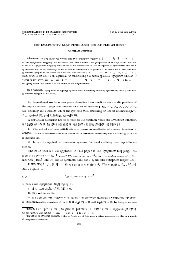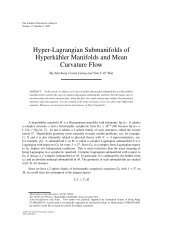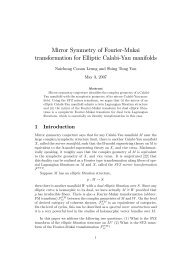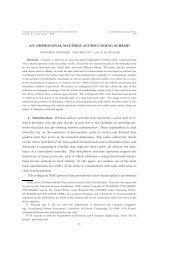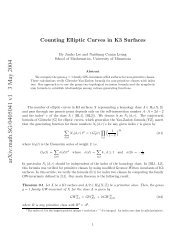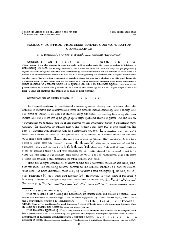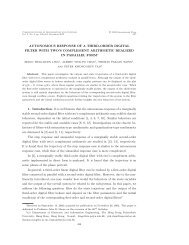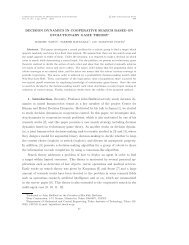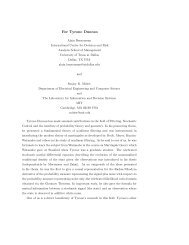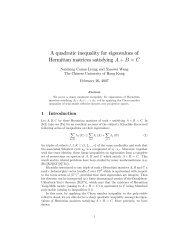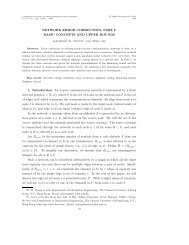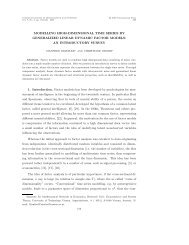Lydia Tapia, Shawna Thomas, and Nancy M. Amato - Texas A&M ...
Lydia Tapia, Shawna Thomas, and Nancy M. Amato - Texas A&M ...
Lydia Tapia, Shawna Thomas, and Nancy M. Amato - Texas A&M ...
You also want an ePaper? Increase the reach of your titles
YUMPU automatically turns print PDFs into web optimized ePapers that Google loves.
COMMUNICATIONS IN INFORMATION AND SYSTEMS<br />
c○ 2010 International Press<br />
Vol. 10, No. 1, pp. 53-68, 2010 004<br />
A MOTION PLANNING APPROACH TO STUDYING MOLECULAR<br />
MOTIONS ∗<br />
LYDIA TAPIA † , SHAWNA THOMAS † , AND NANCY M. AMATO †<br />
Abstract. While structurally very different, protein <strong>and</strong> RNA molecules share an important<br />
attribute. The motions they undergo are strongly related to the function they perform. For example,<br />
many diseases such as Mad Cow disease or Alzheimer’s disease are associated with protein misfolding<br />
<strong>and</strong> aggregation. Similarly, RNA folding velocity may regulate the plasmid copy number, <strong>and</strong> RNA<br />
folding kinetics can regulate gene expression at the translational level. Knowledge of the stability,<br />
folding, kinetics <strong>and</strong> detailed mechanics of the folding process may help provide insight into how<br />
proteins <strong>and</strong> RNAs fold. In this paper, we present an overview of our work with a computational<br />
method we have adapted from robotic motion planning to study molecular motions. We have validated<br />
against experimental data <strong>and</strong> have demonstrated that our method can capture biological<br />
results such as stochastic folding pathways, population kinetics of various conformations, <strong>and</strong> relative<br />
folding rates. Thus, our method provides both a detailed view (e.g., individual pathways) <strong>and</strong> a<br />
global view (e.g., population kinetics, relative folding rates, <strong>and</strong> reaction coordinates) of energy l<strong>and</strong>scapes<br />
of both proteins <strong>and</strong> RNAs. We have validated these techniques by showing that we observe<br />
the same relative folding rates as shown in experiments for structurally similar protein molecules<br />
that exhibit different folding behaviors. Our analysis has also been able to predict the same relative<br />
gene expression rate for wild-type MS2 phage RNA <strong>and</strong> three of its mutants.<br />
1. Introduction. Molecular motions play an essential role in many biochemical<br />
processes. For example, as proteins fold to their native, functional state, they<br />
sometimes undergo critical conformational changes that affect their functionality, e.g.,<br />
diseases such as Mad Cow disease or Alzheimer’s disease are associated with protein<br />
misfolding <strong>and</strong> aggregation [11]. Knowledge of the stability, folding, kinetics <strong>and</strong> detailed<br />
mechanics of the folding process may help provide insight into how <strong>and</strong> why the<br />
protein misfolds. In addition, it has recently been found that some RNA functions<br />
are determined not just by the sequence <strong>and</strong> the resulting native state but also by the<br />
folding process itself, e.g., RNA folding velocity may regulate the plasmid copy number<br />
[21, 33] or RNA folding kinetics can regulate gene expression at the translational<br />
level [40].<br />
Since it is difficult to experimentally observe molecular motions, computational<br />
methods for studying such issues are essential. Traditional computational approaches<br />
for generating folding trajectories such as molecular dynamics (MD) [38, 22, 15, 18]<br />
<strong>and</strong> Monte Carlo simulation [14, 34] are so expensive that they can only be applied to<br />
relatively small structures (e.g., proteins with fewer than 130 amino acids [69]) even<br />
when they use massive computational resources, such as tens of thous<strong>and</strong>s of PCs in<br />
the Folding@Home project [35, 48] or large supercomputers [69]. Statistical mechani-<br />
∗ Dedicated to Michael Waterman on the occasion of his 67th birthday.<br />
† Parasol Lab, Department of Computer Science <strong>and</strong> Engineering, <strong>Texas</strong> A&M University, College<br />
Station, TX 77845. E-mail: {ltapia, sthomas, amato}@cse.tamu.edu<br />
53
54 LYDIA TAPIA, SHAWNA THOMAS, AND NANCY M. AMATO<br />
cal models have been applied to compute statistics related to the energy l<strong>and</strong>scape for<br />
protein [44, 1, 43, 41, 16] <strong>and</strong> RNA [9, 8, 68] molecules. While computationally more<br />
efficient than molecular dynamics or Monte Carlo simulation, these methods do not<br />
produce individual pathway trajectories <strong>and</strong> are limited to studying global averages<br />
of the energy l<strong>and</strong>scape <strong>and</strong> kinetics.<br />
In this paper, we present an overview of a novel computational method for studying<br />
molecular motions that we have developed <strong>and</strong> validated against experimental<br />
data in preliminary work [3, 2, 4, 51, 53, 56, 57, 58, 59, 60, 63, 64]. Our strategy<br />
represents a trade-off between methods such as molecular dynamics <strong>and</strong> Monte Carlo<br />
simulations that provide detailed individual folding trajectories <strong>and</strong> techniques such<br />
as statistical mechanical methods that provide global l<strong>and</strong>scape statistics. Our approach,<br />
derived from probabilistic roadmap methods (PRMs) [30] originally developed<br />
for robotic motion planning, builds a graph corresponding to an approximate map<br />
of the molecule’s energy l<strong>and</strong>scape that encodes many (typically thous<strong>and</strong>s) folding<br />
pathways. Although the individual pathways produced are not as detailed as trajectories<br />
generated from a molecular dynamics simulation, we have shown that they can<br />
be used to study l<strong>and</strong>scape <strong>and</strong> pathway properties such as secondary structure formation<br />
order. We were even able to observe subtle folding differences between protein<br />
G <strong>and</strong> its mutants, NuG1 <strong>and</strong> NuG2 [64], an important ‘benchmark’ set developed by<br />
the Baker Lab [45]. In recent work, we developed new tools to study folding kinetics,<br />
such as the rate at which folding occurs or the time evolution of the population of<br />
particular interesting states. We validated these techniques by showing that we observe<br />
the same relative folding rates as shown in experiments for some small protein<br />
[60] <strong>and</strong> RNA [58, 59] molecules, <strong>and</strong> that our analysis predicts the same relative gene<br />
expression rate for wild-type MS2 phage RNA <strong>and</strong> three of its mutants [58, 59].<br />
2. PRMs for Molecular Motion – Method Overview. Our approach, derived<br />
from probabilistic roadmap methods (PRMs) [30] originally developed for robotic<br />
motion planning, builds a graph corresponding to an approximate map of the molecule’s<br />
energy l<strong>and</strong>scape that encodes many (typically thous<strong>and</strong>s of) folding pathways,<br />
see Figure 1. Our prm-based method follows the general prm paradigm: first conformations<br />
(graph vertices or map nodes) are sampled from the molecule’s energy<br />
l<strong>and</strong>scape (Figure 1(b)), <strong>and</strong> then transitions between ‘nearby’ conformations are<br />
encoded as graph or map edges (Figure 1(c)). As in nature, our strategy favors low<br />
energy conformations <strong>and</strong> transitions. In particular, during the sampling phase, lower<br />
energy samples have a higher retention probability, <strong>and</strong> during the node connection<br />
phase, each connection is assigned a weight to reflect its energetic feasibility. The energetic<br />
feasibility of a transition is determined by the energies of all the intermediate<br />
conformations along the transition. Thus, shortest paths in the map correspond to<br />
the most energetically feasible paths in the map, <strong>and</strong> these maps encode thous<strong>and</strong>s
A MOTION PLANNING APPROACH TO STUDYING MOLECULAR MOTIONS 55<br />
of feasible pathways.<br />
(a) (b) (c)<br />
Fig. 1. (a) The energy l<strong>and</strong>scape is the set of all conformations <strong>and</strong> their associated energy.<br />
Building an approximate map of the energy l<strong>and</strong>scape consists of two steps: (b) conformation sampling<br />
<strong>and</strong> (c) connecting samples together with feasible transitions.<br />
prm-based approaches have been applied to several molecular domains. Singh,<br />
Latombe, <strong>and</strong> Brutlag first applied prms to protein/lig<strong>and</strong> binding [49]. In subsequent<br />
work, our group applied another prm variant to this problem [7]. Our group was the<br />
first to apply prms to model protein folding pathways [4, 3, 53, 52, 50, 62, 61, 64, 60]<br />
<strong>and</strong> RNA folding kinetics [57, 58, 59, 55]. Subsequent to our work, a number of groups<br />
have used prms to study proteins. The work of Apaydin et al. [6, 5] is similarly<br />
motivated but differs from ours in several aspects. First, they model the protein at<br />
a much coarser level, considering all secondary structure elements in the native state<br />
to be already formed <strong>and</strong> rigid. Second, while our focus is on studying the transition<br />
process, their focus has been to compare the prm approach with other computational<br />
methods such as Monte Carlo simulation. More recently, Cortes <strong>and</strong> Simeon used a<br />
prm-based approach to model long loops in proteins [13, 12], <strong>and</strong> Chiang et al. [10]<br />
applied prms to calculate quantities related to protein folding kinetics such as P fold<br />
<strong>and</strong> Φ-value analysis.<br />
Map Analysis Tools for Folding Kinetics. Maps provide an approximate<br />
model of the molecule’s energy l<strong>and</strong>scape. With this model, we can use map-based<br />
analysis tools to study important kinetic measures such as folding rates, equilibrium<br />
distributions, population kinetics, transition states, <strong>and</strong> reaction coordinates. In recent<br />
work [57, 60, 58, 59], we developed two such techniques: Map-based Master<br />
Equation solution (MME) <strong>and</strong> Map-based Monte Carlo simulation (MMC). These<br />
tools are inspired by existing kinetics tools (namely, traditional master equation formalism<br />
<strong>and</strong> st<strong>and</strong>ard Monte Carlo simulation) but can be applied to much larger<br />
molecules because they work on approximate l<strong>and</strong>scape models instead of the complete,<br />
detailed energy l<strong>and</strong>scape.<br />
Map-based Master Equation (MME). The traditional master equation calculation<br />
gives insight into the folding rate, the equilibrium distribution, population kinetics,<br />
<strong>and</strong> transition states [29, 66]. In master equation formalism, the stochastic folding
56 LYDIA TAPIA, SHAWNA THOMAS, AND NANCY M. AMATO<br />
process is represented as a differential equation describing the probability of the folding<br />
process to be in a given state:<br />
(1) dp(t)/dt = Mp(t)<br />
where p(t) is the probability of the folding to be in a given state at time t <strong>and</strong> M<br />
is a matrix of transition-rate constants. The solution to the master equation is a<br />
set of eigenvectors <strong>and</strong> eigenvalues for the matrix M. The spectrum of eigenvalues is<br />
composed of n modes where n is the number of conformations in our map. If sorted<br />
by magnitude in ascending order, the eigenvalues include the zero-valued equilibrium<br />
Boltzmann distribution <strong>and</strong> several small magnitude eigenvalues. The small, non-zero<br />
eigenvalues correspond to the eigenvectors that influence the global folding rate while<br />
large magnitude eigenvalues correspond to fast folding modes, i.e., those that fold in<br />
a burst <strong>and</strong> die away quickly.<br />
Master equation formalism requires a detailed model of the energy l<strong>and</strong>scape.<br />
This has been typically done by enumerating energy l<strong>and</strong>scapes — feasible only for<br />
small molecular models or segments. Instead, we apply the master equation formalism<br />
to our maps (MME) by assigning each node in our map to a row (<strong>and</strong> column) in the<br />
matrix M. The transition rate k ij is computed from the weight w ij of the edge from i<br />
to j as k 0 e −wij where k 0 is a constant coefficient adjusted according to experimental<br />
results.<br />
A key advantage of MME over the traditional master equation solution is that<br />
the cost of MME is proportional to the map size (i.e., the size of the l<strong>and</strong>scape model)<br />
[60], whereas the traditional master equation is usually applied to a fully enumerated<br />
l<strong>and</strong>scape.<br />
Map-based Monte Carlo (MMC). Folding is a stochastic process [29]. In our early<br />
work [4, 3, 53, 50, 61, 57, 64], we simply extracted smallest weight paths from the<br />
map to study folding. However, this does not mirror the stochastic folding process.<br />
In recent work [60, 58, 59], we developed MMC to extract paths r<strong>and</strong>omly based on<br />
transition probabilities. Similar to traditional Monte Carlo simulation, our method<br />
starts from a r<strong>and</strong>om node in the map <strong>and</strong> iteratively chooses a next node based on<br />
the transition probabilities. Just as in MME, the transition probability k ij to transit<br />
from node i to node j is computed from the edge weight w ij as k 0 e −wij where k 0 is<br />
a constant adjusted according to experimental results.<br />
The st<strong>and</strong>ard Monte Carlo method [29, 46] simulates this r<strong>and</strong>om walk in the real<br />
(or complete) energy l<strong>and</strong>scape. These simulations can be computationally intensive<br />
since at each step they must calculate the local energy l<strong>and</strong>scape to choose the next<br />
step. Instead, we apply Monte Carlo simulation directly to our maps. Thus, we are<br />
able to work on larger molecules with our approximated l<strong>and</strong>scape model at only<br />
a small computational cost. Previously, the size of the energy l<strong>and</strong>scape limited<br />
Monte Carlo simulations to small molecules (e.g., all-atom 56 residue protein [47])
A MOTION PLANNING APPROACH TO STUDYING MOLECULAR MOTIONS 57<br />
or molecules whose kinetics were restricted in some way (e.g., Higgs performed a<br />
Monte-Carlo simulation on a 135 residue RNA using only stem-based conformations<br />
[23]).<br />
An important feature of MMC is its computational efficiency in both time <strong>and</strong><br />
memory usage. For instance, we have shown that the cost of MMC is proportional to<br />
the map size <strong>and</strong> model complexity [59]. For 53 to 86 residue proteins, this translates<br />
into 23 to 36 minutes of computation on a 2.4 GHz desktop PC with 512 MB RAM [60].<br />
Correspondingly, the memory usage is also reduced. For example, on a 18 nucleotide<br />
hairpin RNA, 485MB of memory is required to store 1000 traditional Monte Carlo<br />
RNA pathways produced from the program Kinfold [19]. On the other h<strong>and</strong>, 1000<br />
MMC pathways are stored in a file of just 61MB <strong>and</strong> a map of 684KB [59].<br />
3. Protein Motions. We have successfully applied our prm framework for<br />
molecular motions to study protein folding <strong>and</strong> motion [4, 3, 53, 50, 52, 62, 61, 64, 60].<br />
Here we first describe the specifics of our protein application (e.g., protein model, energy<br />
functions, map construction details) <strong>and</strong> then provide results.<br />
3.1. Method Details. Protein Model <strong>and</strong> Energy Function. We model<br />
the protein as an articulated linkage. Using a st<strong>and</strong>ard modeling assumption for<br />
proteins that bond angles <strong>and</strong> bond lengths are fixed [54], the only degrees of freedom<br />
(dof) in our model are the backbone’s phi <strong>and</strong> psi torsional angles which are modeled<br />
as revolute joints with values [0, 2π).<br />
We have used both a coarse energy function similar to [38] <strong>and</strong> an all atom energy<br />
model [36]. For the coarse model, we use a step function approximation of the van der<br />
Waals component <strong>and</strong> model all side chains as equal radii spheres with zero dof. If<br />
two spheres are too close (e.g., their centers are < 2.4Å during sampling <strong>and</strong> < 1.0Å<br />
during connection), a very high potential is returned. Otherwise, the potential is:<br />
(2) U tot = ∑<br />
K d {[(d i − d 0 ) 2 + d 2 c] 1/2 − d c } + E hp<br />
restraints<br />
where K d is 100 kJ/mol <strong>and</strong> d 0 = d c = 2Å as in [38]. The first term represents<br />
constraints favoring known secondary structure through main-chain hydrogen bonds<br />
<strong>and</strong> disulphide bonds, <strong>and</strong> the second term is the hydrophobic effect. The hydrophobic<br />
effect (E hp ) is computed as follows: if two hydrophobic residues are within 6Å of each<br />
other, then the potential is decreased by 20 kJ/mol. A detailed description of our<br />
potential can be found in [4].<br />
Biased Sampling. As previously discussed, samples are retained based on their<br />
energy. In our protein work, a sample q, with potential energy E q , is accepted with<br />
probability:<br />
⎧<br />
⎪⎨ 1 if E q < E min<br />
E<br />
(3) Prob(accept q) = max−E q<br />
E ⎪⎩<br />
max−E min<br />
if E min ≤ E q ≤ E max<br />
0 if E q > E max
58 LYDIA TAPIA, SHAWNA THOMAS, AND NANCY M. AMATO<br />
where E min is the potential energy of the open chain <strong>and</strong> E max is 2E min .<br />
The map produced by our technique is an approximation of the protein’s energy<br />
l<strong>and</strong>scape. The quality of the approximation depends on the sampling strategy.<br />
Generally, we are most interested in regions ‘near’ the native state <strong>and</strong> so seek to<br />
concentrate sampling there. In our original work [4, 3, 53, 50], we obtained a denser<br />
distribution of samples near the native state through an iterative sampling process<br />
where we apply small Gaussian perturbations to existing conformations, beginning<br />
with the native state. This approach works fairly well, but still requires many samples<br />
(e.g., 10,000) for relatively small proteins (e.g., 60–100 residues). In [64], we used<br />
rigidity analysis [26, 27, 28, 25, 37] to determine which portions of the protein to<br />
perturb. This approach increased the protein size we can h<strong>and</strong>le.<br />
Connection. For each node in the map, we attempt to connect it with its k<br />
nearest neighbors with a straight-line in the protein’s energy l<strong>and</strong>scape. The weight<br />
for the edge (q 1 , q 2 ) is a function of the intermediate conformations along the edge<br />
{q 1 = c 0 , c 1 , . . .,c n−1 , c n = q 2 }, where the number of intermediate conformations<br />
depends on the resolution, which is a parameter of the method. For each pair of<br />
consecutive conformations c i <strong>and</strong> c i+1 , the probability P i of transitioning from c i to<br />
c i+1 depends on the difference in their potential energies ∆E i = E(c i+1 ) − E(c i ):<br />
{<br />
e −∆E i<br />
kT if ∆E i > 0<br />
(4)<br />
P i =<br />
1 if ∆E i ≤ 0<br />
This keeps the detailed balance between two adjacent states, <strong>and</strong> enables the weight<br />
of an edge to be computed by summing the negative logarithms of the probabilities<br />
for consecutive pairs of conformations in the sequence. (Negative logs are used since<br />
each 0 ≤ P i ≤ 1.) A similar weight function, with different probabilities, was used in<br />
[49].<br />
MMC Transition Probability. We apply MMC to protein folding as described<br />
previously <strong>and</strong> set the transition probabilities as follows. We cluster the edge weights<br />
into disjoint buckets. Bucket probabilities (Q ij ) are assigned in a biased Gaussian<br />
fashion that favors clear discrimination of low edge weights, yet reflects the relative<br />
differences between edges of all weights. The transition probability between two states,<br />
k ij , is calculated as<br />
(5)<br />
⎧<br />
⎨<br />
k ij =<br />
⎩<br />
Q ij<br />
1+ ∑ n−1<br />
j=0 Qij if j ≠ i<br />
1<br />
1+ ∑ n−1<br />
j=0 Qij if j = i<br />
where n is the number of outgoing edges from node i. This ensures the sum of all<br />
probabilities (including the self-transition probability) out of node i is 1.<br />
3.2. Results. Here we present results that have validated our technique against<br />
experimental data by comparing secondary structure formation order along folding<br />
pathways, relative folding rates, <strong>and</strong> population kinetics for several small proteins.
A MOTION PLANNING APPROACH TO STUDYING MOLECULAR MOTIONS 59<br />
Secondary Structure Formation Order Validation. Proteins are composed<br />
of secondary structure elements (i.e., α-helices <strong>and</strong> β-sheets). Experimental methods,<br />
such as hydrogen exchange mass spectrometry <strong>and</strong> pulse labeling, can investigate<br />
protein folding by identifying which parts of the structure are most exposed or most<br />
protected [65]. From this data, one can infer the secondary structure formation order.<br />
In [3, 50, 53] we compared the secondary structure formation order of folding pathways<br />
extracted from our maps to experimental results [39]. We cluster paths together if<br />
they have the same secondary structure formation order. We then define the dominant<br />
formation order as the formation order of the largest path cluster. Our results are<br />
in good agreement with known experimental results for many small proteins (e.g.,<br />
60–100 amino acids) [64].<br />
Case Study of Proteins G, L, <strong>and</strong> Two Mutants of Protein G. Proteins<br />
G, L, <strong>and</strong> mutants of protein G, NuG1 <strong>and</strong> NuG2 [45], present a good test case for our<br />
technique because they are known to fold differently despite having similar structure<br />
(see Figure 2). All proteins are composed of a central α-helix <strong>and</strong> a 4-str<strong>and</strong>ed β-<br />
sheet: β str<strong>and</strong>s 1 <strong>and</strong> 2 form the N-terminal hairpin (β1-2) <strong>and</strong> β str<strong>and</strong>s 3 <strong>and</strong> 4<br />
form the C-terminal hairpin (β3-4). Native state out-exchange experiments <strong>and</strong> pulse<br />
labeling/competition experiments for proteins G <strong>and</strong> L indicate that β1-2 forms first<br />
in protein L, <strong>and</strong> β3-4 forms first in protein G [39]. This is consistent with Φ-value<br />
analysis on G [42] <strong>and</strong> L [31]. In Nauli et al. [45], protein G is mutated to increase<br />
the stability of β1-2. Φ-value analysis indicates that the hairpin formation order for<br />
both NuG1 <strong>and</strong> NuG2 is switched from the wild-type. Nauli et al. also show that<br />
NuG1 <strong>and</strong> NuG2 fold 100 times faster than protein G.<br />
Our initial iterative Gaussian sampling strategy was able to accurately capture<br />
the folding differences between protein G <strong>and</strong> L, but not between protein G <strong>and</strong> NuG1<br />
or NuG2 [53]. Our iterative rigidity-based sampling strategy, however, was able to<br />
also capture the correct folding behavior of NuG1 <strong>and</strong> NuG2 [64], see Table 1.<br />
In addition to detecting the correct folding behavior, our rigidity-based technique<br />
also helped explain the stability shift in NuG1 <strong>and</strong> NuG2. Figure 2 displays the<br />
rigidity maps of each protein’s native state. A rigidity map is a graphical view of the<br />
rigid <strong>and</strong> flexible portions of the structure. Black regions correspond to rigid regions<br />
<strong>and</strong> green regions correspond to slightly flexible regions. In all four proteins, the<br />
central α helix remains completely rigid, <strong>and</strong> we also see increased rigidity in β1-2<br />
from protein G to NuG1 <strong>and</strong> NuG2 as suggested in [45].<br />
Finally, we have used MME <strong>and</strong> MMC to compute the relative folding rates<br />
between protein G, NuG1, <strong>and</strong> NuG2 from our maps [60]. Figure 3(a) shows the<br />
magnitudes of the 5 smallest eigenvalues for each protein as calculated by MME.<br />
Recall that the smallest non-zero eigenvalues represent the rate-limiting barrier in the<br />
folding process. Therefore, they have the largest impact on the global folding rate. As<br />
seen in the magnitude of the second eigenvalue in Figure 3(a), protein G folds much
60 LYDIA TAPIA, SHAWNA THOMAS, AND NANCY M. AMATO<br />
(a)<br />
(b)<br />
(c)<br />
(d)<br />
Fig. 2. Ribbons diagrams <strong>and</strong> rigidity maps of the native state for protein G (a), protein<br />
L (b), <strong>and</strong> mutants NuG1 (c) <strong>and</strong> NuG2 (d). Mutated portions are displayed in wireframe. In<br />
the rigidity maps, rigid clusters are black <strong>and</strong> dependent hinge sets are shaded/green. Figure<br />
originally published in [64].<br />
slower than the two mutants, NuG1 <strong>and</strong> NuG2. Also, NuG1 <strong>and</strong> NuG2 fold at very<br />
similar rates. This trend is also seen in the curves of the MMC population kinetics for<br />
protein G (Figure 3(b)) <strong>and</strong> mutants, NuG1 (Figure 3(b)) <strong>and</strong> NuG2 (Figure 3(c)).<br />
Both of these computational results match what has been seen in lab experiments<br />
[45].<br />
4. RNA Motion. In our previous work [57, 55, 58, 59], we developed several<br />
successful map construction techniques for RNA. In particular, the Probabilistic Boltzmann<br />
Sampling (PBS) method builds the smallest maps (up to 10 orders of magnitude<br />
smaller than completely enumerated maps) <strong>and</strong> enables us to study much larger RNA,<br />
up to 200 nucleotides. Similarly with proteins, we provide several map-based analysis<br />
tools including a Map-based Master Equation (MME) <strong>and</strong> Map-based Monte Carlo<br />
(MMC) simulation to extract folding kinetics.<br />
4.1. Method Details. RNA Model <strong>and</strong> Energy Function. In the results<br />
demonstrated here, we focus on the formation of secondary structure. Secondary<br />
structure is a planar representation of an RNA conformation, which is commonly used<br />
to study RNA folding [70, 71, 24]. We adopt the definition in [24] that eliminates other<br />
types of contacts that are not physically favored. We use a common energy function
A MOTION PLANNING APPROACH TO STUDYING MOLECULAR MOTIONS 61<br />
Table 1<br />
Comparison of secondary structure formation orders for proteins G, L, NuG1, <strong>and</strong> NuG2<br />
with known experimental results:<br />
1 hydrogen out-exchange experiments [39], 2 pulsed labeling/competition<br />
experiments [39], <strong>and</strong> 3 Φ-value analysis [45]. Brackets indicate no clear<br />
order. In all cases, our technique predicted the secondary structure formation order seen in<br />
experiment. Only formation orders greater than 1% are shown.<br />
Protein Experimental Formation Order Rigidity Formation Order %<br />
G [α,β1,β3,β4], β2 1 [α,β4], [β1,β2,β3] 2 α, β3-4, β1-2 99.4<br />
L [α,β1,β2,β4], β3 1 [α,β1], [β2,β3,β4] 2 β1-2, α, β3-4 100.0<br />
NuG1 β1-2, β3-4 3 α, β1-2, β3-4 97.6<br />
β1-2, α, β3-4 1.6<br />
NuG2 β1-2, β3-4 3 α, β1-2, β3-4 96.6<br />
β1-2, α, β3-4 1.1<br />
β3-4, β1-2, α 1.1<br />
Roadmap Eigenvalues<br />
10 2 Eigenvalue Index<br />
10 1<br />
Protein G<br />
NuG1<br />
NuG2<br />
Eigenvalue Magnitude<br />
10 0<br />
10 −1<br />
10 −2<br />
10 −3<br />
10 −4<br />
1 2 3 4 5<br />
(a)<br />
(b)<br />
(c)<br />
(d)<br />
Fig. 3. Population kinetics for protein G <strong>and</strong> mutants NuG1 <strong>and</strong> NuG2. NuG1 <strong>and</strong><br />
NuG2 are experimentally known to fold 100 times faster than protein G [45]. (a) MME<br />
eigenvalue comparison. (b-d) MMC kinetics for protein G (b), NuG1 (c), <strong>and</strong> NuG2 (d).<br />
Figure originally published in [60].<br />
called the Turner or nearest neighbor rules [70].<br />
Biased Sampling. Our sampling method, Probabilistic Boltzmann Sampling<br />
(PBS), uses Wuchty’s method [67] to enumerate suboptimal (low energy) conformations<br />
within a given energy threshold. We take these suboptimal conformations as
62 LYDIA TAPIA, SHAWNA THOMAS, AND NANCY M. AMATO<br />
“seeds” <strong>and</strong> include additional r<strong>and</strong>om conformations. Then, we use a probabilistic<br />
filter to retain a subset of the conformations based on their Boltzmann distribution<br />
factors. For a given conformation q with free energy E q , the probability of keeping it<br />
is:<br />
(6)<br />
Prob(accept q) =<br />
{<br />
e −(Eq −E 0 )<br />
kT if (E q − E 0 ) > 0<br />
1 if (E q − E 0 ) ≤ 0<br />
where E 0 is a reference energy threshold that we can use to control the number of<br />
samples kept.<br />
Connection. Similar to Section 3.1, we calculate a weight w ij for edge (q i , q j )<br />
that reflects the Boltzmann transition probability between q i <strong>and</strong> q j . First, we determine<br />
the energy barrier (the maximum energetic cost) E b between q i <strong>and</strong> q j . Then,<br />
we calculate the Boltzmann transition probability k ij (or transition rate) of moving<br />
from q i to q j using Metropolis rules [17]:<br />
{<br />
e −∆E<br />
kT if ∆E > 0<br />
(7)<br />
k ij =<br />
1 if ∆E ≤ 0<br />
where ∆E = max(E b , E j )−E i , k is the Boltzmann constant, <strong>and</strong> T is the temperature.<br />
Note that the same energy barrier E b is also used to estimate the transition probability<br />
k ji , so the calculation satisfies the detailed balance. As in protein folding, the edge<br />
weight w ij is the negative logarithm of the transition probability.<br />
MMC Transition Probability. We apply MMC to RNA folding as described in<br />
Section 2. Because the edge weight w ij encodes the transition probability k ij between<br />
two endpoints i <strong>and</strong> j, we can calculate k ij as k 0 e −wij where k 0 is a constant adjusted<br />
according to experimental results. Results presented here are generated using a fast<br />
variant of the st<strong>and</strong>ard Monte Carlo method [46]. Full technical details are available<br />
in previous work [58, 59].<br />
4.2. Results. Here we demonstrate results for several different RNA. We have<br />
validated our technique against other computational methods <strong>and</strong> have shown that<br />
we can capture the same folding kinetics as seen in experiment.<br />
Computational Validation: 1k2g. 1k2g (CAGACUUCGGUCGCAGAGAU-<br />
GG) is a 22 nucleotide RNA with a hairpin native state [32]. Figure 4(a–e) compares<br />
the population kinetics of the native state using (a) st<strong>and</strong>ard Monte Carlo simulation<br />
(implemented by Kinfold [19]), (b) Map-based Monte Carlo simulation on a fully<br />
enumerated map (12,137 conformations), (c) Map-based Monte Carlo simulation on a<br />
map with our PBS sampling method (42 conformations), <strong>and</strong> (d) the master equation<br />
on a PBS map (42 conformations). While the fully enumerated map (b) is the most<br />
accurate model, it is not feasible to enumerate RNA with more than 40 nucleotides<br />
<strong>and</strong> numerical limitations in computing the eigenvalues <strong>and</strong> eigenvectors limit the<br />
master equation to small maps (e.g., up to 10,000 conformations). The population
A MOTION PLANNING APPROACH TO STUDYING MOLECULAR MOTIONS 63<br />
kinetics curves all have similar features: the population first increases quickly, then<br />
gradually decreases, <strong>and</strong> eventually stabilizes at the equilibrium (final) distribution,<br />
which are all roughly 80%. Hence, these analysis methods all yield similar results <strong>and</strong><br />
indicate that the PBS map (c,d) effectively approximates the energy l<strong>and</strong>scape with<br />
less than 0.4% of all possible conformations.<br />
1<br />
Population Kinetics: 1k2g, Kinfold 2000 run<br />
1<br />
Population Kinetics: 1k2g, BPE map, MMC<br />
0.9<br />
0.9<br />
0.8<br />
0.8<br />
Population P<br />
0.7<br />
0.6<br />
0.5<br />
0.4<br />
Population P<br />
0.7<br />
0.6<br />
0.5<br />
0.4<br />
0.3<br />
0.3<br />
0.2<br />
0.2<br />
0.1<br />
0.1<br />
1<br />
0<br />
10 −2 10 −1 10 0 10 1 10 2 10 3<br />
Path Steps<br />
(a)<br />
Population Kinetics: 1k2g, PBS map, MMC<br />
0<br />
10 −1 10 0 10 1 10 2 10 3 10 4<br />
1<br />
Path Steps<br />
(b)<br />
Population Kinetics: 1k2g, PBS map, ME<br />
(e)<br />
0.9<br />
0.9<br />
0.8<br />
0.8<br />
Population P<br />
0.7<br />
0.6<br />
0.5<br />
0.4<br />
Population P<br />
0.7<br />
0.6<br />
0.5<br />
0.4<br />
0.3<br />
0.3<br />
0.2<br />
0.2<br />
0.1<br />
0.1<br />
0<br />
10 −2 10 −1 10 0 10 1 10 2 10 3<br />
Path Steps<br />
(c)<br />
0<br />
10 −2 10 −1 10 0 10 1 10 2 10 3<br />
Path Steps<br />
(d)<br />
(f)<br />
Fig. 4. The population kinetics of the native state of 1k2g (a-e): (a) Kinfold Monte Carlo<br />
simulation, (b) our MMC simulation on a fully enumerated map (12,137 conformations), (c)<br />
our MMC simulation on a PBS map (42 conformations), <strong>and</strong> (d) master equation solution<br />
on the PBS map (42 conformations). All analysis techniques produce similar population<br />
kinetics curves <strong>and</strong> similar equilibrium distributions. (e) Comparison of the eigenvalues of<br />
1k2g by the master equation on a fully enumerated map (12,137 conformations) <strong>and</strong> new<br />
PBS map (42 conformations). Both eigenvalues are similar between the different maps. (f)<br />
Comparison of the 10 smallest non-zero eigenvalues (i.e., the folding rates) for WT <strong>and</strong><br />
MM7 of ColE1 RNAII as computed by the master equation. The overall folding rate of WT<br />
is faster than MM7 matching experimental data. Figure originally published in [59].<br />
Experimental Validation: ColE1 <strong>and</strong> Mutant MM7. ColE1 RNAII regulates<br />
the replication of E. coli ColE1 plasmids through its folding kinetics [21, 33]. The<br />
slower it folds, the higher the plasmid replication rate. A specific mutant, MM7, differs<br />
from the wild-type (WT) by a single nucleotide out of the 200 nucleotide sequence.<br />
This mutation causes it to fold slower while maintaining the same thermodynamics of<br />
the native state. Thus, the overall plasmid replication rate increases in the presence<br />
of MM7 over the WT. We studied this difference computationally by computing the<br />
folding rates of both WT <strong>and</strong> MM7 using MME <strong>and</strong> comparing their eigenvalues (the<br />
smallest non-zero eigenvalue corresponds to the folding rate). As seen in Figure 4(f),<br />
all eigenvalues of WT are larger than MM7 indicating that WT folds faster. Thus,<br />
our method correctly estimated the functional level of the new mutant.
64 LYDIA TAPIA, SHAWNA THOMAS, AND NANCY M. AMATO<br />
Experimental Validation: MS2 Phage RNA Mutants. MS2 phage RNA<br />
(135 nucleotides) regulates the expression rate of phage MS2 maturation protein [20,<br />
33] at the translational level. It works as a regulator only when a specific subsequence<br />
(the SD sequence) is open (i.e., does not form base-pair contacts). Since this SD<br />
sequence is closed in the native state, the RNA can only regulate the expression<br />
rate before the folding process finishes. Thus, its function is based on its folding<br />
kinetics <strong>and</strong> not the final native structure. Three mutants have been studied that<br />
have similar thermodynamic properties as the wild-type (WT) but have different<br />
kinetics <strong>and</strong> therefore different gene expression rates. Experimental results indicate<br />
that mutant CC3435AA has the highest gene expression rate, WT <strong>and</strong> mutant U32C<br />
are similar, <strong>and</strong> mutant SA has the lowest rate [20, 33].<br />
We estimate the gene expression rate by integrating the opening probability of<br />
the SD sequence over the entire folding process. Note that the RNA regulates gene<br />
expression only when the SD opening probability is “high enough”. We used thresholds<br />
ranging from 0.2 to 0.6 to estimate the gene expression rate. Thresholds higher<br />
than 0.6 will yield zero opening probability for WT <strong>and</strong> most mutants <strong>and</strong> thus cannot<br />
be correlated to experimental results. Similarly, we do not consider thresholds<br />
lower than 0.2, because otherwise mutant SA would be active even in the equilibrium<br />
condition which does not correspond to experimental results. Table 2 shows our<br />
simulation results. For most thresholds, mutant CC3435AA has the highest rate <strong>and</strong><br />
mutant SA has the lowest rate, the same relative functional rate as seen in experiment.<br />
In addition, WT <strong>and</strong> mutant U32C have similar levels (particularly between<br />
0.4-0.6), again correlating with experimental results. These results also suggest that<br />
the SD sequence may only be active for gene regulation when more than 40% of its<br />
nucleotides are open.<br />
Table 2<br />
Comparison of expression rates between WT <strong>and</strong> three mutants of MS2. It shows that<br />
we can predict similar relative functional rates as seen in experiment.<br />
Experimental Expression Rate<br />
Our Estimation<br />
Mutant (order of magnitude) t = 0.2 t = 0.3 t = 0.4 t = 0.5 t = 0.6<br />
SA 0.1 0.1 0.04 0.03 0.03 0.08<br />
WT 1 1.0 1.0 1.0 1.0 1.0<br />
U32C 1 2.1 1.8 1.4 0.8 1.2<br />
CC3435AA 5 7.2 8.4 3.8 3.5 9.8<br />
5. Conclusion. We have presented an overview of a computational technique<br />
based on algorithms for robot motion planning that can study both protein <strong>and</strong> RNA<br />
motion. Our technique builds an approximate map, or model, of the molecule’s energy<br />
l<strong>and</strong>scape. With this model, we have extracted folding pathways <strong>and</strong> study l<strong>and</strong>scape<br />
properties including relative folding rates <strong>and</strong> population kinetics. We have validated<br />
our technique by comparing it to other computational methods <strong>and</strong> to experimental
A MOTION PLANNING APPROACH TO STUDYING MOLECULAR MOTIONS 65<br />
data. We have shown that our method produces pathways with the same secondary<br />
structure formation order as seen in experiment for several small proteins, including<br />
the structurally similar ‘benchmark’ set of proteins G, L, <strong>and</strong> mutants of G. Our<br />
technique also has reported the same relative folding rates for protein G <strong>and</strong> its<br />
mutants. For RNA, we have compared the population kinetics from our technique<br />
against another popular computational method. We also have shown that we predict<br />
the same relative folding rates for ColE1 <strong>and</strong> its mutant <strong>and</strong> the same relative gene<br />
expression rates for MS2 phage RNA <strong>and</strong> its mutants as seen in experiment.<br />
Acknowledgments. This research supported in part by NSF Grants EIA-01037-<br />
42, ACR-0081510, ACR-0113971, CCR-0113974, ACI-0326350, CRI-0551685, CCF-<br />
0833199, CCF-0830753, by Chevron, IBM, Intel, HP, <strong>and</strong> by King Abdullah University<br />
of Science <strong>and</strong> Technology (KAUST) Award KUS-C1-016-04. <strong>Tapia</strong> supported in part<br />
by a Sloan scholarship, PEO scholarship, NIH Molecular Biophysics Training Grant<br />
(T32GM065088) <strong>and</strong> a Department of Education (GAANN) Fellowship. <strong>Thomas</strong><br />
supported in part by an NSF Graduate Research Fellowship, a PEO scholarship, a<br />
Dept. of Education Graduate Fellowship (GAANN), <strong>and</strong> an IBM TJ Watson PhD<br />
Fellowship.<br />
REFERENCES<br />
[1] E. Alm <strong>and</strong> D. Baker. Prediction of protein-folding mechanisms from free-energy l<strong>and</strong>scapes<br />
derived from native structures. Proc. Natl. Acad. Sci. USA, 96:20(1999), pp. 11305–11310.<br />
[2] N. M. <strong>Amato</strong>, K. A. Dill, <strong>and</strong> G. Song. Using motion planning to map protein folding<br />
l<strong>and</strong>scapes <strong>and</strong> analyze folding kinetics of known native structures. In: Proc. Int. Conf.<br />
Comput. Molecular Biology (RECOMB), pages 2–11, 2002.<br />
[3] N. M. <strong>Amato</strong>, K. A. Dill, <strong>and</strong> G. Song. Using motion planning to map protein folding<br />
l<strong>and</strong>scapes <strong>and</strong> analyze folding kinetics of known native structures. J. Comput. Biol., 10:3-<br />
4(2003), pp. 239–255. Special issue of Int. Conf. Comput. Molecular Biology (RECOMB)<br />
2002.<br />
[4] N. M. <strong>Amato</strong> <strong>and</strong> G. Song. Using motion planning to study protein folding pathways. J.<br />
Comput. Biol., 9:2(2002), pp. 149–168. Special issue of Int. Conf. Comput. Molecular<br />
Biology (RECOMB) 2001.<br />
[5] M. Apaydin, D. Brutlag, C. Guestrin, D. Hsu, <strong>and</strong> J.-C. Latombe. Stochastic roadmap<br />
simulation: An efficient representation <strong>and</strong> algorithm for analyzing molecular motion. In:<br />
Proc. Int. Conf. Comput. Molecular Biology (RECOMB), pages 12–21, 2002.<br />
[6] M. Apaydin, A. Singh, D. Brutlag, <strong>and</strong> J.-C. Latombe. Capturing molecular energy l<strong>and</strong>scapes<br />
with probabilistic conformational roadmaps. In: Proc. IEEE Int. Conf. Robot.<br />
Autom. (ICRA), pages 932–939, 2001.<br />
[7] O. B. Bayazit, G. Song, <strong>and</strong> N. M. <strong>Amato</strong>. Lig<strong>and</strong> binding with OBPRM <strong>and</strong> haptic user<br />
input: Enhancing automatic motion planning with virtual touch. In: Proc. IEEE Int.<br />
Conf. Robot. Autom. (ICRA), pages 954–959, 2001. This work was also presented as a<br />
poster at RECOMB 2001.<br />
[8] S. Cao <strong>and</strong> S.-J. Chen. Predicting RNA folding thermodynamics with a reduced chain representation<br />
model. RNA, 11(2005), pp.1884–1897.
66 LYDIA TAPIA, SHAWNA THOMAS, AND NANCY M. AMATO<br />
[9] S.-J. Chen <strong>and</strong> K. A. Dill. RNA folding energy l<strong>and</strong>scapes. Proc. Natl. Acad. Sci. USA,<br />
97(2000), pp. 646–651.<br />
[10] T.-H. Chiang, D. Hsu, M. S. Apaydin, D. L. Brutlag, <strong>and</strong> J.-C. Latombe. Predicting<br />
experimental quantities in protein folding kinetics using stochastic roadmap simulation.<br />
In: Proc. Int. Conf. Comput. Molecular Biology (RECOMB), pages 410–424, 2006.<br />
[11] F. Chiti <strong>and</strong> C. Dobson. Protein misfolding, functional amyloid, <strong>and</strong> human disease. Annu.<br />
Rev. Biochem., 75(2006), pp. 333–366.<br />
[12] J. Cortés <strong>and</strong> T. Siméon. Sampling-based motion planning under kinematic loop-closure<br />
constraints. In: Algorithmic Foundations of Robotics VI, pages 75–90. Springer,<br />
Berlin/Heidelberg, 2005. book contains the proceedings of the International Workshop<br />
on the Algorithmic Foundations of Robotics (WAFR), Utrecht/Zeist, The Netherl<strong>and</strong>s,<br />
2004.<br />
[13] J. Cortés, T. Siméon, M. Remaud-Siméon, <strong>and</strong> V. Tran. Geometric algorithms for the<br />
conformational analysis of long protein loops. J. Computat. Chem., 25:7(2004), pp. 956–<br />
967.<br />
[14] D. Covell. Folding protein α-carbon chains into compact forms by Monte Carlo methods.<br />
Proteins: Struct. Funct. Genet., 14:4(1992), pp. 409–420.<br />
[15] V. Daggett <strong>and</strong> M. Levitt. Realistic simulation of naive-protein dynamics in solution <strong>and</strong><br />
beyond. Annu. Rev. Biophys. Biomol. Struct., 22(1993), pp. 353–380.<br />
[16] P. Das, S. Matysiak, <strong>and</strong> C. Clementi. Balancing energy <strong>and</strong> entropy: A minimalist<br />
model for the characterization of protein folding l<strong>and</strong>scapes. Proc. Natl. Acad. Sci. USA,<br />
102:29(2005), pp. 10141–10146.<br />
[17] K. A. Dill <strong>and</strong> H. S. Chan. From Leventhal to pathways to funnels. Nat. Struct. Biol.,<br />
4(1997), pp. 10–19.<br />
[18] Y. Duan <strong>and</strong> P. Kollman. Pathways to a protein folding intermediate observed in a 1-<br />
microsecond simulation in aqueous solution. Science, 282(1998), pp. 740–744.<br />
[19] C. Flamm. Kinetic Folding of RNA. PhD thesis, University of Vienna, Austria, August 1998.<br />
[20] H. Groeneveld, K. Thimon, <strong>and</strong> J. van Duin. Translational control of matruation-protein<br />
synthesis is phage MS2: a role of the kinetics of RNA folding? RNA, 1(1995), pp. 79–88.<br />
[21] A. P. Gultyaev, F. H. van Batenburg, <strong>and</strong> C. W. Pleij. The computer simulation of RNA<br />
folding pathways using a genetic algorithm. J. Mol. Biol., 250(1995), pp. 37–51.<br />
[22] J. Haile. Molecular Dynamics Simulation: elementary methods. Wiley, New York, 1992.<br />
[23] P. G. Higgs. RNA secondary structure: physical <strong>and</strong> computational aspects. Quarterly<br />
Reviews of Biophysics, 33(2000), pp. 199–253.<br />
[24] I. L. Hofacker. RNA secondary structures: A tractable model of biopolymer folding. J.<br />
Theor. Biol., 212(1998), pp. 35–46.<br />
[25] D. Jacobs. Generic rigidity in three-dimensional bond-bending networks. J. Phys. A: Math.<br />
Gen., 31(1998), pp. 6653–6668.<br />
[26] D. Jacobs <strong>and</strong> M. Thorpe. Generic rigidity percolation: The pebble game. Phys. Rev. Lett.,<br />
75:22(1995), pp. 4051–4054.<br />
[27] D. Jacobs <strong>and</strong> M. Thorpe. Generic rigidity percolation in two dimensions. Phys. Rev. E,<br />
53:4(1996), pp. 3682–3693.<br />
[28] D. J. Jacobs <strong>and</strong> B. Hendrickson. An algorithm for two dimensional rigidity percolation:<br />
The pebble game. J. Comp. Phys, 137(1997), pp. 346–368.<br />
[29] N. G. V. Kampen. Stochastic Processes in Physics <strong>and</strong> Chemistry. North-Holl<strong>and</strong>, New York,<br />
1992.<br />
[30] L. E. Kavraki, P. Švestka, J. C. Latombe, <strong>and</strong> M. H. Overmars. Probabilistic roadmaps for<br />
path planning in high-dimensional configuration spaces. IEEE Trans. Robot. Automat.,<br />
12:4(1996), pp. 566–580.<br />
[31] D. E. Kim, C. Fisher, <strong>and</strong> D. Baker. A breakdown of symmetry in the folding transition
A MOTION PLANNING APPROACH TO STUDYING MOLECULAR MOTIONS 67<br />
state of protein L. J. Mol. Biol., 298(2000), pp. 971–984.<br />
[32] A. Kitamura, Y. Muto, S. Watanabe, I. Kim, T. Ito, Y. Nishiya, K. Sakamoto, T. Ohtsuki,<br />
G. Kawai, K. Watanabe, K. Hosono, H. Takaku, E. Katoh, T. Yamzaki, T. Inoue,<br />
<strong>and</strong> S. Yokoyama. Solution structure of an RNA fragment with the P7/P9.0 region<br />
<strong>and</strong> the 3’-terminal guanosine of the tetrahymena group I intron. RNA, 8(2002), pp.<br />
440–451.<br />
[33] P. Klaff, D. Riesner, <strong>and</strong> G. Steger. RNA structure <strong>and</strong> the regulation of gene expression.<br />
Plant Mol. Biol., 32(1996), pp. 89–106.<br />
[34] A. Kolinski <strong>and</strong> J. Skolnick. Monte Carlo simulations of protein folding. Proteins Struct.<br />
Funct. Genet., 18:3(1994), pp. 338–352.<br />
[35] S. M. Larson, C. Snow, <strong>and</strong> V. S. P<strong>and</strong>e. Folding@Home <strong>and</strong> Genome@Home: Using<br />
distributed computing to tackle previously intractable problems in computational biology.<br />
Modern Methods in Computational Biology. R. Grant, ed, Horizon Press, 2003.<br />
[36] T. Lazaridis <strong>and</strong> M. Karplus. Effective energy function for proteins in solution. Proteins,<br />
35(1999), pp. 133–152. http://mingus.sci.ccny.cuny.edu/server/.<br />
[37] A. Lee <strong>and</strong> I. Streinu. Pebble game algorithms <strong>and</strong> sparse graphs. European Conference on<br />
Combinatorics, Graph Theory <strong>and</strong> Applications, 2005.<br />
[38] M. Levitt. Protein folding by restrained energy minimization <strong>and</strong> molecular dynamics. J.<br />
Mol. Biol., 170(1983), pp. 723–764.<br />
[39] R. Li <strong>and</strong> C. Woodward. The hydrogen exchange core <strong>and</strong> protein folding. Protein Sci.,<br />
8:8(1999), pp. 1571–1591.<br />
[40] C. Ma, T. Kolesnikow, J. Rayner, E. Simons, H. Yim, <strong>and</strong> R. Simons. Control of translation<br />
by mRNA secondary structure: the importance of the kinetics of structure formation. Mol.<br />
Microbiol., 14(994), pp. 1033–1047.<br />
[41] S. Matysiak <strong>and</strong> C. Clementi. Optimal combination of theory <strong>and</strong> experiment for the characterization<br />
of the protein folding l<strong>and</strong>scape of s6: How far can a minimalist model go?<br />
J. Mol. Biol., 343:1(2004), pp. 235–248.<br />
[42] E. L. McCallister, E. Alm, <strong>and</strong> D. Baker. Critical role of β-hairpin formation in protein<br />
G folding. Nat. Struct. Biol., 7:8(2000), pp. 669–673.<br />
[43] V. Muñoz <strong>and</strong> W. A. Eaton. A simple model for calculating the kinetics of protein folding<br />
from three dimensional structures. Proc. Natl. Acad. Sci. USA, 96:20(1999), pp. 11311–<br />
11316.<br />
[44] V. Muñoz, E. R. Henry, J. Hoferichter, <strong>and</strong> W. A. Eaton. A statistical mechanical model<br />
for β-hairpin kinetics. Proc. Natl. Acad. Sci. USA, 95(1998), pp. 5872–5879.<br />
[45] S. Nauli, B. Kuhlman, <strong>and</strong> D. Baker. Computer-based redesign of a protein folding pathway.<br />
Nature Struct. Biol., 8:7(2001), pp. 602–605.<br />
[46] M. E. J. Newman <strong>and</strong> G. T. Barkenma. Monte Carlo Methods in Statistical Physics. Clarendon<br />
Press, Oxford, 1999.<br />
[47] J. Shimada <strong>and</strong> E. I. Shakhnovich. The ensemble folding kinetics of protein G from an allatom<br />
Monte Carlo simulation. Proc. Natl. Acad. Sci. USA, 99:17(2002), pp. 11175–11180.<br />
[48] M. Shirts <strong>and</strong> V. P<strong>and</strong>e. Screen savers of the world unite. Science, 290(2000), pp. 1903–1904.<br />
[49] A. P. Singh, J.-C. Latombe, <strong>and</strong> D. L. Brutlag. A motion planning approach to flexible<br />
lig<strong>and</strong> binding. In: Int. Conf. on Intelligent Systems for Molecular Biology (ISMB), pages<br />
252–261, 1999.<br />
[50] G. Song. A Motion Planning Approach to Protein Folding. Ph.D. dissertation, Dept. of<br />
Computer Science, <strong>Texas</strong> A&M University, December 2004.<br />
[51] G. Song <strong>and</strong> N. M. <strong>Amato</strong>. Using motion planning to study protein folding pathways. In:<br />
Proc. Int. Conf. Comput. Molecular Biology (RECOMB), pages 287–296, 2001.<br />
[52] G. Song <strong>and</strong> N. M. <strong>Amato</strong>. A motion planning approach to folding: From paper craft to<br />
protein folding. IEEE Trans. Robot. Automat., 20(2004), pp. 60–71. Preliminary version
68 LYDIA TAPIA, SHAWNA THOMAS, AND NANCY M. AMATO<br />
appeared in ICRA 2001, pp. 948-953.<br />
[53] G. Song, S. <strong>Thomas</strong>, K. Dill, J. Scholtz, <strong>and</strong> N. <strong>Amato</strong>. A path planning-based study of<br />
protein folding with a case study of hairpin formation in protein G <strong>and</strong> L. In: Proc.<br />
Pacific Symposium of Biocomputing (PSB), pages 240–251, 2003.<br />
[54] M. J. Sternberg. Protein Structure Prediction. OIRL Press at Oxford University Press, 1996.<br />
[55] X. Tang. Tools for Modeling <strong>and</strong> Analyzing RNA <strong>and</strong> Protein Folding Energy L<strong>and</strong>scapes.<br />
PhD thesis, Dept. of Computer Science, <strong>Texas</strong> A&M University, December 2007.<br />
[56] X. Tang, B. Kirkpatrick, S. <strong>Thomas</strong>, G. Song, <strong>and</strong> N. M. <strong>Amato</strong>. Using motion planning to<br />
study RNA folding kinetics. In: Proc. Int. Conf. Comput. Molecular Biology (RECOMB),<br />
pages 252–261, 2004.<br />
[57] X. Tang, B. Kirkpatrick, S. <strong>Thomas</strong>, G. Song, <strong>and</strong> N. M. <strong>Amato</strong>. Using motion planning<br />
to study RNA folding kinetics. J. Comput. Biol., 12:6(2005), pp. 862–881. Special issue<br />
of Int. Conf. Comput. Molecular Biology (RECOMB) 2004.<br />
[58] X. Tang, S. <strong>Thomas</strong>, L. <strong>Tapia</strong>, <strong>and</strong> N. M. <strong>Amato</strong>. Tools for simulating <strong>and</strong> analyzing RNA<br />
folding kinetics. In: Proc. Int. Conf. Comput. Molecular Biology (RECOMB), pages<br />
268–282, 2007.<br />
[59] X. Tang, S. <strong>Thomas</strong>, L. <strong>Tapia</strong>, D. P. Giedroc, <strong>and</strong> N. M. <strong>Amato</strong>. Simulating RNA folding<br />
kinetics on approximated energy l<strong>and</strong>scapes. J. Mol. Biol., 381(2008), pp. 1055–1067.<br />
[60] L. <strong>Tapia</strong>, X. Tang, S. <strong>Thomas</strong>, <strong>and</strong> N. M. <strong>Amato</strong>. Kinetics analysis methods for approximate<br />
folding l<strong>and</strong>scapes. Bioinformatics, 23:13(2007), pp. 539–548. Special issue of Int. Conf.<br />
on Intelligent Systems for Molecular Biology (ISMB) & European Conf. on Computational<br />
Biology (ECCB) 2007.<br />
[61] S. <strong>Thomas</strong>, G. Song, <strong>and</strong> N. <strong>Amato</strong>. Protein folding by motion planning. Physical Biology,<br />
2(2005), pp. S148–S155.<br />
[62] S. <strong>Thomas</strong>, G. Tanase, L. K. Dale, J. M. Moreira, L. Rauchwerger, <strong>and</strong> N. M. <strong>Amato</strong>.<br />
Parallel protein folding with STAPL. Concurrency <strong>and</strong> Computation: Practice <strong>and</strong><br />
Experience, 17:14(2005), pp. 1643–1656.<br />
[63] S. <strong>Thomas</strong>, X. Tang, L. <strong>Tapia</strong>, <strong>and</strong> N. M. <strong>Amato</strong>. Simulating protein motions with rigidity<br />
analysis. In: Proc. Int. Conf. Comput. Molecular Biology (RECOMB), pages 394–409,<br />
2006.<br />
[64] S. <strong>Thomas</strong>, X. Tang, L. <strong>Tapia</strong>, <strong>and</strong> N. M. <strong>Amato</strong>. Simulating protein motions with rigidity<br />
analysis. J. Comput. Biol., 14:6(2007), pp. 839–855. Special issue of Int. Conf. Comput.<br />
Molecular Biology (RECOMB) 2006.<br />
[65] T. E. Wales <strong>and</strong> J. R. Engen. Hydrogen exchange mass spectrometry for the analysis of<br />
protein dynamics. Mass Spec. Rev., 25:1(2006), pp. 158–170.<br />
[66] T. Weikl, M. Plassini, <strong>and</strong> K. Dill. Coopertivity in two-state protein folding kinetics.<br />
Protein Sci., 13(2004), pp. 822–829.<br />
[67] S. Wuchty. Suboptimal secondary structures of RNA. Master’s thesis, University of Vienna,<br />
Austria, March 1998.<br />
[68] W. Zhang <strong>and</strong> S. Chen. RNA hairpin-folding kinetics. Proc. Natl. Acad. Sci. USA, 99(2002),<br />
pp. 1931–1936.<br />
[69] R. Zhou, M. Eleftheriou, C.-C. Hon, R. S. Germain, A. K. Royyuru, <strong>and</strong> B. J. Berne.<br />
Massively parallel molecular dynamics simulations of lysozyme unfolding. IBM J. Res. &<br />
Dev., 52:1/2(2008), pp. 19–30.<br />
[70] M. Zuker, D. H. Mathews, <strong>and</strong> D. H. Turner. Algorithms <strong>and</strong> thermodynamics for RNA<br />
secondary structure prediction: A practical guide. In: J. Barciszewski <strong>and</strong> B. F. C. Clark,<br />
editors, RNA Biochemistry <strong>and</strong> Biotechnology, NATO ASI Series. Kluwer Academic Publishers,<br />
1999.<br />
[71] M. Zuker <strong>and</strong> D. Sankoff. RNA secondary structure <strong>and</strong> their prediction. Bulletin of<br />
Mathematical Biology, 46(1984), pp. 591–621.




